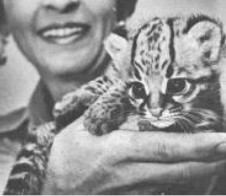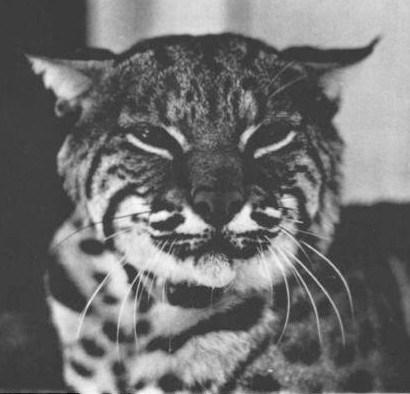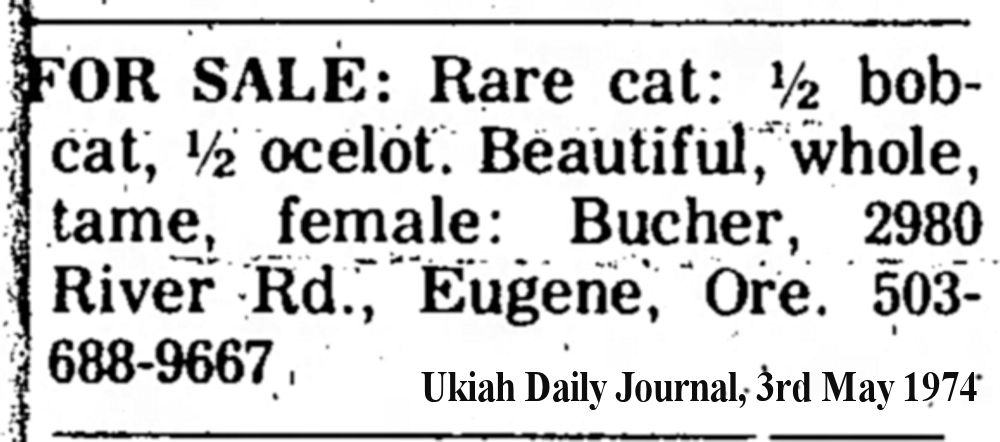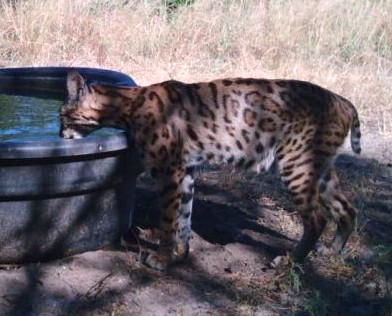
|
OCELOT, MARGAY, ONCILLA (TIGER CAT) & GEOFFROY'S CAT HYBRIDS |
In captivity, the ocelot hybridizes with the other small South American spotted cats such as the Margay (L. wiedii), Tiger cat (L. tigrinus), Geoffroy's cat (O. geoffroyi), and the kodkod (Oncifelis guigna) (Newman et al., 1985), and some of these cats may interbreed where their rangers overlap.
ONCILLA/MARGAY HYBRIDS
In the 1950s or 1960s there were attempts to cross-breed the Little Spotted Cat (F tigrina, also called the Oncilla) with the Margay (F wiedi) by Dutch cat specialist Mme Falkena-Rohrle. Mme Falkena-Rohrle. She kept the cats alongside her Abyssinian breeding cats and succeeded in breeding domestc x Oncilla hybrids using a domestic Abyssinian male and a female Oncilla. Before he was crossed to an Abyssinian female, her Oncilla male x Margay female produced some beautiful hybrid kittens according to the one report I could find.
ONCILLA/GEOFFROY'S CAT HYBRIDS
A paper published in 2006 suggested that Oncillas and Geoffroy's Cats may hybridise in parts of southern Brazil where their territories overlap. The paper contained 3 photos: one of an oncilla, one of a Geoffroy's Cat and one of a possible hybrid. Eizirik and colleagues characterised the geographic distribution of these two closely related felids in southern Brazil, where their ranges met. Individuals with atypical coat color patterns which appeared to be mixtures of characteristics of the two different species were observed in overlap region. This suggested to the researchers that hybridization may occur in the contact zone. Since these cats are somewhat variable in colour, hybrids annot be confirmed on visual appearance alone.
E Eizirik, C Indrusiak, TC Trigo, DA Sana, FD Mazim and TRO Freitas (Autumn 2006) Refined Mapping and Characterization of the Geographic Contact Zone Between Oncilla and Geoffroy’s Cat in Southern Barzil. IUCN Cat News 45: 8-11.
In 2013, Brazilian esearchers reported that there were two distinct populations - north-eastern and southern - of Leoardus tigrinus (Oncilla/Tiger Cat) in Brazil which did not interbreed with each other and which were evolutionarily distinct. In contrast, the two populations interbred with the closely related Pampas Cat and the Geoffroy's cat. DNA was collected from Pampas Cats (L colocolo) in the north of Brazil, and from Geoffroy's cats (L. geoffroyi) in the south and also from the two separate populations the Oncilla. Chromosomal and mitochondrial DNA markers showed that the southern Oncilla population actively interbred with Geoffroy's cat in areas where the two species came into contact. There was evidence of ancient hybridisation, but not current interbreeding, between the north eastern Oncilla and the Pampas cat. The lack of evidence for interbreeding between the southern and north-eastern populations of the Oncilla elevated these to being separate species. The rarer north eastern Oncillas remain L tigrinus while the newly recognised southern Oncilla becomes L guttulus.
Tatiane C. Trigo, Alexsandra Schneider, Tadeu G. de Oliveira, Livia M. Lehugeur, Leandro Silveira, Thales R.O. Freitas, Eduardo Eizirik "Molecular Data Reveal Complex Hybridization and a Cryptic Species of Neotropical Wild Cat" Current Biology, 27 November 2013.
MARGAY/OCELOT HYBRIDS (MARLOT)
In discussing Marlot, it must be remembered that in the 1950s and 1960s, cubs were taken from mothers killed for fur and many owners didn't know whether they had a Margay or an Ocelot. Margays were also called ocelots (or tree ocelots) while the others were called "true ocelots".
In the Long Island Ocelot Club (LIOC) Newsletter Aug 1973, Ginny Story wrote: My aim, of course, is to produce a "Marlot"(?) with Seymour and take a little of the load off Fenwyck (her bobcat/ocelot male). They've already become very friendly. We built him a large home adjacent, filled with perches & tunnels which Seymour shares with him at intervals, informing him that she is still Boss, tho! Well, time will tell, but I figured if there are ocebobs there can also be ocegays.

Marlot "Precious" (1977) at 6 weeks pictured courtesy of the Long Island ocelot Club.
The Long Island Ocelot Club Newsletter Aug 76 carried the following announcement: In the believe it or not department, the family of Mrs B Brock announce the birth of a male kitten. We are somewhat at a loss what to call this kit as the father is a domestic born margay and the mother a domestic born ocelot ... I guess it's a marlot? The parents were obtrained about the same time and raised together - they're now about 3 and a half years old. It must be noted that the father is a largish margay and mama is a small ocelot which would help matters we suppose. At this writing the feline family is doing well.
Barbara Brock wrote an account of the marlot in the Long Island Ocelot Club (LIOC) Newsletter Feb 1977: The cast of characters are as follows: Cha-cha, the ocelot mother, Macho, the margay father and Precious the baby marlot. Between 6:00 and 6:30 AM on the morning of September l0th, Cha Cha presented us with her kitten ... a darling surprisingly vocal little girl marlot. She was only a few ounces of movement in a slick spotted coat and the first kitten of a margay and ocelot mating. We called Mr. Douglas about a month before the kitten was born and told him we thought ChaCha might be pregnant, but what signs should we look for? He told us the only outward sign we could find was the pinkness of her nipples. She kept her shape beautifully. We had discussed the possibility of a margay/ocelot mating with Mr. Douglas and Mr. Hatfield - both fantastic and well known cat breeders...and the Godparents to our marlot child. Anyway, Mr. Douglas said he had been trying to get them to crossbreed for years without any luck ... I don't think he really thought there was any chance, but he was surprised when I called him about 6:31 AM and said "What do I do now?"
To be perfectly honest, we didn't do a thing to encourage this mating. We got our margay and ocelot when they were very young - only six weeks old and let them take up housekeeping together. They have however, never seen one of their own kind, only each other and they are very close in size as Macho is about 16 pounds and ChaCha a very small ocelot at about 18 pounds. We feel that one of the conditions most conducive to this matinq was the fact that we have a very large walled back yard and the cats can play in the yard and trees and spend a great deal of time outdoors. [...] Our [marlot] baby, sickening as it sounds, is called Precious. Her eyes opened when she was 19 days old, they are large, But I still can't definately say she has margay eyes. She does resemble both of her parents. Her rosettes are darker like the margay and her coat is golden but she has the ever so pink nose of her ocelot mother and the ocelot tail. We are planning to sell our kitten when the right person comes along. I hope whoever takes her will attempt t o breed her in the hopes of finding out more about the differences and likenesses of the two species. Besides that, we feel that we will have more marlots in the future as Macho has really got it and lives up to his name in every respect."
Another Marlot, called Baby, was mentioned in 1980.
BOBCAT/OCELOT HYBRIDS
Although these hybrids have been bred in captivity, they are unlikely to occur in the wild. These have adjoining ranges which overlap in Mexico and the southern USA. A hybrid is unlikely as they prefer different habitats and have different lifestyles. Bobcats inhabits woodland, scrub, semi-desert and swampland. Ocelots prefer denser cover and are more arboreal. However, in 2012/3 it was reported that around 10% of live-trapped bobcats in parts of Texas have ocelot-style spotting
Their sizes are similar. Bobcats average 36 inches (90 cm) long including tail; 14 -15 inches (36-38 cm) at the shoulders and weigh 16-30 pounds (7-14 kg). Ocelots can reach 38 inches (100 cm) excluding tail and weigh 20-33 pounds (10-15 kg). Spotted subspecies of bobcat occur and retained juvenile spotting is also possible.
The LIOC newsletter for September 1966 boasted "A Really New Cat - An Ocelynx!" Details came from a letter dated Aug 11 1966 from John C. Ebner of Wichita Falls, Texas. Ebner wrote "I have a new little kitten that is now three months old and whose daddy is an ocelot and his mother is a bobcat. We are calling this kitten an ocelynx. although I guess it might be a bobelot. He weighed six pounds today when I had him declawed. We are most anxious to see him grow. Right now he looks more bobcat than ocelot. His name is 'Bruni' for the Texas town where he was born." A newspaper cutting from the same time period outlined an Ocelot x Bobcat cross-breeding programme at Ranier State School, Buckley. Washington, under the direction of Dr HC Thuline.

A breeder in Texas specialised in bobcat-ocelot crosses in the late 1960s one of which is pictured courtesy of the Long Island ocelot Club (escapees may be the source of the ocelot-like bobcats now trapped in Texas)
An advert appeared in the Long Island Ocelot Club Newsletter Nov/Dec for 1969 saying: "Ocebob, bobelot or whatever you choose to call them, they are with us and AVAILABLE ! Gertrude Troop [Troop's Pet Shop, Bruni, Texas] advises that she has had and will have from time to time, ocelot x bobcat kittens bred from her Mexican Ocelot and a Texas bobcat. Both parents are about four years old. Ocebob kittens sell for $200 each." Gertrude Troop appears to be the source of the ocebobs mentioned in the newsletters.
Regularly featured in the Long Island Ocelot Club Newsletter from 1967 into the 1970s was Fenwyck, the Ocebob owned by Ginny and Jim Story of Southern California. Fenwyck was one of Troop's first ocebobs, bred in 1967. Ms Story also owned an ocelot (Seymour) and a puma (McCavity). Fenwyck showed an interest in McCavity and the Storys believed a successful mating would produce the world's first "ocebobacougalot". (As an F1 hybrid, Fenwyck would have been sterile). In the newsletter of Nov 1968, Fenwyck was described as a really beautiful cat having spotted/striped body of the ocelot yet head and tail of the bobcat, although his tail was long for a bobcat.
In the LIOC newsletter for March-April 1975, Story wrote: "Fenwyck is a Texas ocebob, 8 years old and one of Gertrude Troop's first litters in a successful mating between her bobcat and ocelot. He was 5 months old when I bought him for $75 in Azuza, from a young man who couldn't handle him and didn't know what he had. I'd just lost my very first ocelot tragically to three dogs, but I was determined that his death would not be in vain; I had learned from my bumbling mistakes as many of us have and the Fenwyck is shy. I respect his independence and free spirit . He will not allow me to pet him and others to come close, but this is his home and the two females who grew up with him and share his life.
In the LIOC newsletter for Jan-Feb 1970, another ocebob called Maggie was described. Maggie was a very young ocebob bred by Troop and owned by WR (Bill) Boyle of Tacoma, Washington. Boyle wrote "She arrived from Gertrude Troop, Bruni, Texas, in mid-November. She is about 7 weeks old, weighs close to 2 pounds and is as tame as any domestic kitten. She was raised from birth by hand and bottle. I might add that my vet said she is extremely healthy and free of parasites."


About 10% of ocelots live-trapped in parts of Texas where their ranges overlap show ocelot-type markings which are quite different form the spotting seen on some bobcats. These may just be natural variation (similar to the King Cheetah's markings) or may point to hybridisation between the species where their habitats overlap.
CLOUDED LEOPARD HYBRIDS
Clouded leopard hybrids have been suggested. The intention would appear to be hybridisation with domestic cats rather than with big cats. No actual Clouded Leopard hybrids are known - Clouded Leopards are the smallest of the big cats and probably cannot be hybridized with domestic cats - although a similar size difference proved no obstacle to ocelot/puma matings.
REFERENCES AND FURTHER READING
For more information on the genetics of colour and pattern:
Robinson's Genetics for Cat Breeders & Veterinarians 4th Ed (the current version)
For more information on genetics, inheritance and gene pools see:
The Pros and Cons of Inbreeding
The Pros and Cons of Cloning
For more information on anomalous colour and pattern forms in big cats see
Karl Shuker's "Mystery Cats of the World" (Robert Hale: London, 1989 - some of the genetics content is outdated)
|
BACK TO HYBRID & MUTANT BIG CATS INDEX |